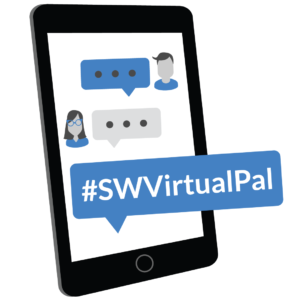Using LinkedIn for #SWVirtualPal
Editor’s note: This post is cross-published on the Social Work Virtual Pal website. Social Work Virtual Pal is a global and virtual community of practice for the social work profession, that digitizes the practice of having a pen pal for professional learning and networking. This community focuses on connection and collaboration among social workers to offer the profession with an opportunity to harness its collective knowledge for the greater good. We have resources for social work educators so, please consider incorporating #SWVirtualPal in your social work course. Learn about Social Work Virtual Pal here.
Social Work Virtual Pal now has a LinkedIn Group for social work students, instructors, and practitioners to connect with other social workers around the world. Similar to our Twitter account, this is a virtual space that digitizes the practice of having a pen pal for professional learning and networking. In addition, this community focuses on connection and collaboration among social workers to offer the profession an opportunity to harness its collective knowledge for the greater good. In this blog post, we offer details for creating a LinkedIn Profile, establishing your digital networking goals, and then joining our LinkedIn Group to find your #SWVirtualPal.
Where to start
LinkedIn is a social networking site designed specifically for professional use and offers a robust user profile system that serves as a digital resume. It is a great place to establish your online presence as a social work student or practitioner. As with any social media platform, you’ll want to start with creating your LinkedIn profile. There are many online tutorials on creating a high-quality LinkedIn profile, and LinkedIn’s Help feature offers many tips and guides on navigating the platform. Before getting started with your profile, you will want to have a professional-looking photo and a copy of your resume handy. Set aside a few hours to create your profile. Here is a good profile checklist designed for college students, but applicable to anyone.
Because #SWVirtualPal is designed to help social workers from around the world connect with other social workers, there are some additional features to consider adding to your profile:
- Include your gender pronouns
- Record & display your name pronunciation on your profile
- Create profiles in other languages
If you are a social work student, consider working with your institution’s career services office. Often, they will help you with professional headshots or help you set up your profile. It is important to control the public-facing information of your profile and to keep it updated regularly.
Establish your goals for digital networking
After setting up your profile, think about your goals for digital networking as a social worker. What do you want to learn? Who do you want to meet? In their article,
Hill & Lineback (2011) recommend that everyone needs three networks:
- Operational – network you need to do your day-to-day work
- Developmental – network of individuals you trust and who support you
- Strategic – network that shows you the future and how to prepare it
Ideally, you will want all three networks. However, this last network – the strategic one – requires an intention to develop. Most of us do not naturally connect with others to prepare for future work projects because these are individuals with whom we do not come into contact regularly.
Another way to explore your goals for digital networking is by searching for hashtags that are relevant to your areas of interest. One way to think about hashtags is that they are keywords that help quickly identify topics or interests for posts in LinkedIn. When you know the relevant hashtags for your professional interests, you can quickly sort through content to determine what is relevant to your networking goals. For example, check out the Symplur Healthcare Hashtag Project for a comprehensive listing of hashtags related to health and well-being. #SWVirutalPal is registered with Symplur, which will show you the latest tweets and top influencers.
Learn & observe the norms
As with any new digital space, it is vital to learn the norms of the LinkedIn platform. For example, LinkedIn is specifically designed to connect professionals around the world. Thus, users are often more formal and work-oriented in presenting themselves and discussing issues on the platform. Another norm on LinkedIn is that connections are meant for individuals who you know and trust. Thus, you do not have to accept a connection request from someone you don’t know. Alternatively, you will want to make a personalized request of someone you do not know when making a connection request on LinkedIn. You can learn more about LinkedIn’s norms by observing how others post comments or set up their profiles. Another way is to read LinkedIn’s Professional Community Policies and their Publishing Platform Guidelines, which operationalize its values. As you read through these guidelines, consider and compare them with the social work ethical code that applies to your region or area of practice.
Connect with relevant people and organizations
As you start to connect with people on LinkedIn, start individuals and groups you already know. These are your peers and the individuals in your operational and developmental networks. Use the connection feature in LinkedIn to view someone’s profile and posts. Reconnect with those you may have lost touch with by using the LinkedIn Messaging feature or commenting on their posts. One way to connect with someone you may not know is to write an invitation to connect. Try an elevator speech approach to your invitation by explaining who you are, what you do, and then asking a question. If you are not ready to connect with some, try following an individual, which means you can see what they post on LinkedIn. For example, follow social workers including students, instructors, practitioners, researchers, and social work organizations. You can also join a LinkedIn group, which includes members who share interests or experiences.
Joining the Social Work Virtual Pal Group
To find your #SWVirutalPal, join our Social Work Virtual Pal group. It is a professional connection and discussion group, and we invite social work practitioners, students, and educators from around the world to join. Here are the group’s guidelines:
- Guideline #1: Connect to find your Social Work Virtual Pal
- Guideline#2: Only post relevant content – social work profession, professional development, networking
- Guideline #3: Bring value to the discussions – encourage one another, be nice, share resources for creating connections
- Guideline #4: Keep it professional – be respectful in language, questions, and comments
- Guideline#5: Respect the group guidelines
Once in the group, use these tips to find and connect with your #SWVirutalPal.
Share your insights and stories by posting in #SWVirtualPal Group
Here are some ways you can start a group conversation within the #SWVirutalPal group:
- What is something you learned recently?
- Run a Poll to gut check or ask a questions
- Respond to questions from other users in a friendly manner
- Like and share valuable content (sharing while giving credit to the original provider of info).
- Find and share trustworthy articles and links in your area of expertise.
- Thank people who have liked or commented on your posts
- Give credit to people who have provided the resources you’re sharing.
- Use LinkedIn Reactions (i.e., emojis) to participate in group conversations
You can learn more about Social Work Virtual Pal by visiting our website. Do you already have a #SWVirtualPal? If so, share your comments below. We would love to hear from you.
How to cite:
Hitchcock, L.I. (2021, September 8). Using LinkedIn for #SWVirtualPal. Teaching and Learning in Social Work. https://laureliversonhitchcock.org/2021/09/08/using-linkedin-for-swvirtualpal/




